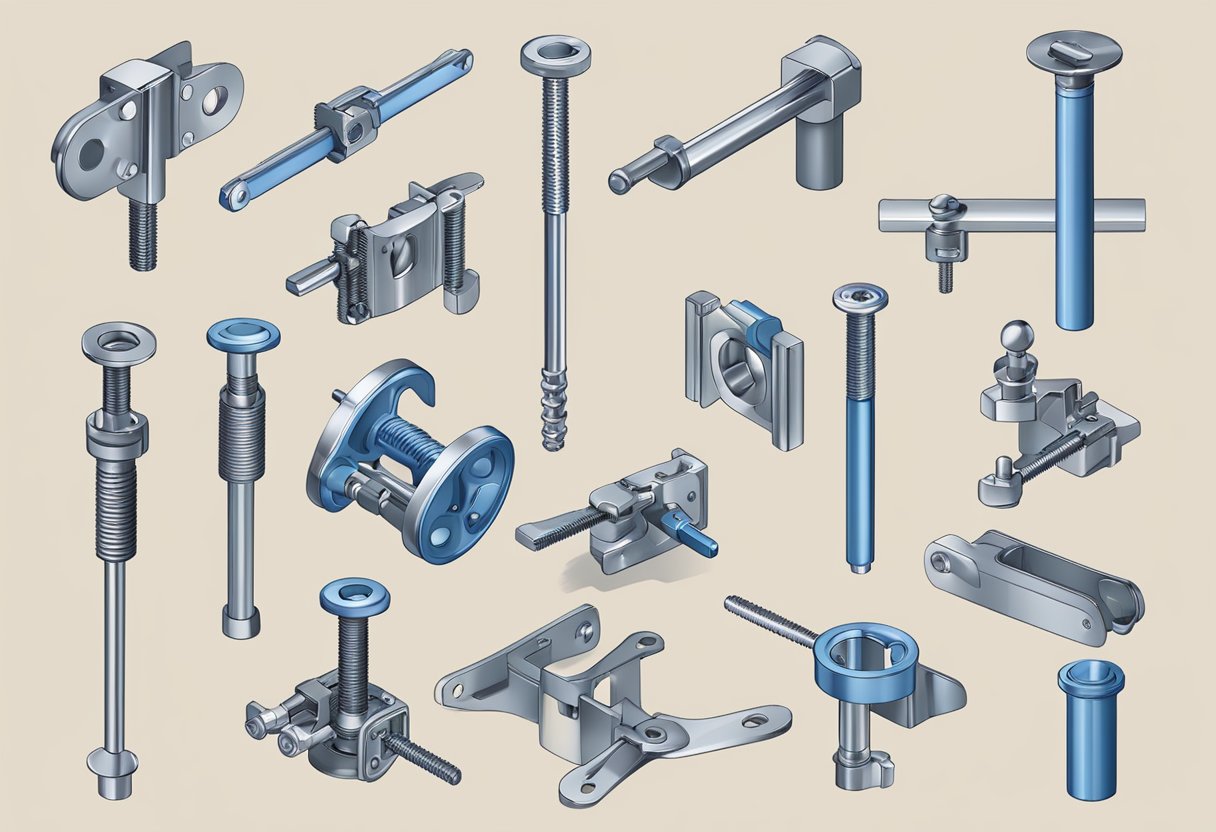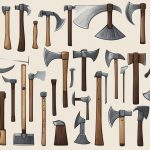Types Of Clamps
Clamps are a versatile tool used to secure and hold objects in place during various activities such as woodworking, metalworking, and construction. There are many different types of clamps available, each designed for specific tasks and materials. Choosing the right clamp for the job is crucial to ensure a successful outcome.
Types of Clamps by Mechanism
Clamps can be categorized by their mechanism, such as screw clamps, lever clamps, and spring clamps. Screw clamps are the most common type and are used for a wide range of applications. Lever clamps are quick and easy to use, while spring clamps are lightweight and portable.
Material-Specific Clamps
Some clamps are designed for use with specific materials, such as pipe clamps for plumbing work and miter clamps for woodworking. Other examples include welding clamps for metalworking and vacuum clamps for holding non-porous materials.
Specialized Clamps for Tasks
There are also specialized clamps available for specific tasks, such as edge clamps for holding workpieces at a right angle and band clamps for clamping irregularly shaped objects. These clamps are designed to make certain tasks easier and more efficient.
Key Takeaways
- There are many different types of clamps available, each designed for specific tasks and materials.
- Clamps can be categorized by their mechanism, material-specific use, and specialized use.
- Choosing the right clamp for the job is crucial to ensure a successful outcome.
Types of Clamps by Mechanism

Clamps are an essential tool for holding objects in place while performing various tasks. There are many different types of clamps available, each with its own unique mechanism. In this section, we will explore the most common types of clamps by mechanism.
Screw Clamps
Screw clamps, also known as “C-clamps,” are a type of clamp that uses a threaded screw to apply pressure and hold objects in place. The screw is turned using a handle, which moves the stationary jaw towards the movable jaw, applying pressure to the object being clamped. Screw clamps are commonly used in woodworking, metalworking, and welding applications.
Lever-Operated Clamps
Lever-operated clamps, also known as “toggle clamps,” use a lever to apply pressure and hold objects in place. The lever is connected to a linkage that moves the stationary jaw towards the movable jaw, applying pressure to the object being clamped. Lever-operated clamps are commonly used in woodworking, metalworking, and welding applications.
Spring Clamps
Spring clamps, also known as “pinch clamps,” use a spring to apply pressure and hold objects in place. The jaws of the clamp are connected by a spring, which applies pressure to the object being clamped. Spring clamps are commonly used in woodworking, photography, and other applications where a quick and easy clamp is needed.
Quick-Release Clamps
Quick-release clamps, also known as “one-handed clamps,” use a trigger mechanism to apply pressure and hold objects in place. The trigger is pressed to open the jaws of the clamp, and released to close them. Quick-release clamps are commonly used in woodworking, metalworking, and other applications where a quick and easy clamp is needed.
Overall, the type of clamp used will depend on the task at hand. Screw clamps are ideal for applications where a high amount of pressure is needed, while lever-operated clamps are ideal for applications where a quick and easy clamp is needed. Spring clamps and quick-release clamps are ideal for applications where a quick and easy clamp is needed, but a lower amount of pressure is required.
Material-Specific Clamps
When it comes to clamping materials, different types of clamps are designed to work with specific materials. This section will cover some of the most common material-specific clamps used in woodworking, metalwork, and plastic and rubber applications.
Woodworking Clamps
Woodworking clamps are designed to work with wood and wood joinery. Some of the most common woodworking clamps include:
- Bar clamps: These clamps consist of a long bar with a sliding jaw that can be tightened to apply pressure to the workpiece.
- Pipe clamps: These clamps use a length of pipe as the bar and can be customized to fit different lengths of pipe.
- C-clamps: These clamps have a C-shaped frame and a screw that can be tightened to apply pressure to the workpiece.
- Spring clamps: These clamps use a spring to apply pressure to the workpiece and are great for holding small pieces in place.
Metalwork Clamps
Metalwork clamps are designed to work with metal and are often used in welding and other metalworking applications. Some of the most common metalwork clamps include:
- Welding clamps: These clamps are designed to hold metal pieces together during welding and other metalworking processes.
- Magnetic clamps: These clamps use magnets to hold metal pieces in place and are great for holding odd-shaped pieces.
- Vise grips: These clamps have a locking mechanism that allows them to grip onto a workpiece and hold it in place.
Plastic and Rubber Clamps
Plastic and rubber clamps are designed to work with these materials and are often used in automotive and other mechanical applications. Some of the most common plastic and rubber clamps include:
- Hose clamps: These clamps are used to secure hoses onto fittings and are commonly used in automotive applications.
- Cable ties: These clamps use a plastic strap to secure cables and wires in place and are commonly used in electrical applications.
- Rubber-lined clamps: These clamps have a rubber lining that helps to grip onto the workpiece without damaging it. They are commonly used in automotive and plumbing applications.
Overall, choosing the right clamp for the job is essential to ensure a secure and stable workpiece. By understanding the different types of clamps available and their specific applications, you can choose the best clamp for your project.
Specialized Clamps for Tasks
When it comes to specialized clamps, there are a variety of options available for different tasks. In this section, we will discuss some of the most common specialized clamps and their uses.
Gluing and Joining Clamps
Gluing and joining clamps are designed to hold pieces of wood or other materials together while glue dries or they are being joined together. Some of the most common types of gluing and joining clamps include:
-
C-Clamps: C-clamps are a basic type of clamp that is used to hold two pieces of material together while glue dries. They are easy to use and come in a variety of sizes.
-
Bar Clamps: Bar clamps are similar to C-clamps, but they have a longer bar that allows them to hold larger pieces of material. They are also adjustable, which makes them ideal for a variety of different projects.
-
Pipe Clamps: Pipe clamps are designed to hold pieces of material together using a pipe as a clamp. They are ideal for larger projects and can be adjusted to fit a variety of different sizes.
Cutting and Drilling Clamps
Cutting and drilling clamps are designed to hold materials in place while they are being cut or drilled. Some of the most common types of cutting and drilling clamps include:
-
Miter Clamps: Miter clamps are used to hold pieces of material together while they are being cut at an angle. They are ideal for carpentry and woodworking projects.
-
Vise Clamps: Vise clamps are designed to hold materials in place while they are being drilled. They are adjustable and can be used with a variety of different materials.
-
C-Clamps: C-clamps can also be used for cutting and drilling projects. They are easy to use and come in a variety of sizes.
Welding and Fabrication Clamps
Welding and fabrication clamps are designed to hold pieces of metal together while they are being welded or fabricated. Some of the most common types of welding and fabrication clamps include:
-
F-Clamps: F-clamps are designed to hold pieces of metal together while they are being welded or fabricated. They are adjustable and can be used with a variety of different materials.
-
Locking Clamps: Locking clamps are designed to hold pieces of metal together while they are being welded or fabricated. They are adjustable and can be used with a variety of different materials.
-
Magnetic Clamps: Magnetic clamps are designed to hold pieces of metal together using magnets. They are ideal for welding and fabrication projects.
Overall, there are many different types of specialized clamps available for a variety of different tasks. When choosing a clamp, it is important to consider the task at hand and select a clamp that is appropriate for the job.
Clamp Designs and Their Uses
C-Clamps and G-Clamps
C-Clamps and G-Clamps are the most common types of clamps used in woodworking, metalworking, and industrial applications. C-Clamps are shaped like the letter “C” and have a screw mechanism to adjust the clamp’s width. G-Clamps, also known as “sash clamps,” have a similar design but are heavier and more durable.
Both C-Clamps and G-Clamps are used for holding workpieces and materials in place during drilling, welding, and other tasks. They are also useful for clamping objects to a workbench or table.
Bar and Pipe Clamps
Bar and Pipe Clamps are used for clamping long, narrow objects like pipes, bars, and boards. Bar Clamps have a long, flat bar with a screw mechanism that tightens the clamp around the workpiece. Pipe Clamps have a similar design but are specifically designed for clamping pipes.
Bar and Pipe Clamps are useful for woodworking, metalworking, and construction projects where long, narrow objects need to be held securely in place.
Corner and Angle Clamps
Corner and Angle Clamps are used for holding workpieces at a specific angle. Corner Clamps have two jaws that are set at a 90-degree angle, while Angle Clamps have adjustable jaws that can be set to any angle.
Corner and Angle Clamps are useful for woodworking, metalworking, and construction projects where precise angles are required. They are also useful for holding objects in place while glue or other adhesives dry.
In conclusion, there are many different types of clamps available, each with its own strengths and weaknesses. By understanding the different clamp designs and their uses, you can choose the right clamp for your specific project and ensure that your workpiece or material is held securely in place.
Choosing the Right Clamp
When it comes to clamping, there are several factors that one should consider before making a purchase. Different clamps are designed for specific tasks, and choosing the right clamp can make all the difference in the success of a project. Here are some important factors to consider when selecting a clamp:
Clamp Size and Capacity
The size and capacity of a clamp are crucial when it comes to selecting the right one for a particular task. For woodworking or furniture making, a smaller clamp may suffice, while larger workpieces may require a larger clamp with greater capacity. It’s important to take into account the thickness of the material being clamped, as well as the amount of pressure needed to hold it in place.
Clamp Strength and Durability
The strength and durability of a clamp are also important factors to consider. For automotive repair or other heavy-duty tasks, a clamp made from steel may be necessary to withstand the pressure. For lighter tasks, a clamp made from a different material may be sufficient. It’s important to choose a clamp that is strong enough to hold the material in place without breaking or slipping.
Clamp Features and Innovations
Finally, it’s important to consider any additional features or innovations that a clamp may offer. For example, some clamps come with a quick-release mechanism that allows for easy removal, while others may have a pivoting jaw that can clamp at different angles. These features can make a clamp more versatile and easier to use, depending on the task at hand.
Overall, when selecting a clamp, it’s important to take into account the specific task at hand and the material being clamped. By considering factors such as size, strength, and features, one can choose the right clamp for the job and ensure a successful outcome.






